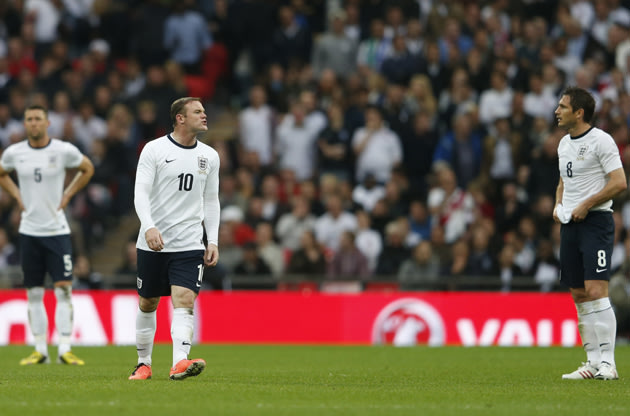Just four days after a gripping Champions League final had hundreds of millions of fans enthralled by the high level of technique and ability on display, it was an unfortunate comparison to make.
And in the very same stadium where Juergen Klopp’s lavishly talented Borussia Dortmund side were defeated by a late goal from Bayern Munich’s Arjen Robben, on a night that illuminated Wembley’s huge stands, when delivered it felt almost ludicrous - especially following a desperately dour draw between two of international football’s less impressive sides.
“There's been far too much discussion about systems,” said Roy Hodgson following a 1-1 draw with Ireland. “We look to find systems. I was asked to do programme notes for UEFA about the systems Bayern and Dortmund had brought to European football, but Borussia Dortmund played 4-4-2 in the same way we played 4-4-2.”
Cue some raised eyebrows worthy of Carlo Ancelotti. Was one of 4-4-2’s most committed disciples comparing himself to the trendiest coach in European football?
On closer examination, though, this wasn’t a completely outrageous claim, purely in terms of the system at least. Without the ball, Dortmund had Kevin Grosskreutz tuck in on the left to make them more compact and the hard working Jakub Blaszczykowski also dropped back to flank Sven Bender and Ilkay Gundogan. Meanwhile, Marco Reus played off Robert Lewandowski, so if Klopp’s formation was not a pure, English-style 4-4-2 then it was at least 4-4-1-1 when on the back foot.
England had a similar complexion against Ireland. Hodgson’s famous two banks of four were in full effect but Rooney also played a bit deeper than Daniel Sturridge, and then Jermain Defoe following an injury to the Liverpool striker. As a bristling Hodgson said when the tactical issue was brought up in his post-match press conference: "You say it was a 4-4-2. Was Wayne Rooney a midfield player, one who plays behind the front player, or is he an out-and-out front player?"
Rooney – though some way short of his best form after a season that ended in turmoil due to his insistence on leaving Manchester United - was actually most effective when coming off the front to play between the lines. In the second half he dinked a neat ball over for Theo Walcott, combined with Phil Jones in a lovely one-touch move and then played in the same team-mate with a cute angled pass to open up the defence – all from a position just outside the box.
Squint, and could that be Reus on Saturday night, tormenting Dante and Jerome Boateng with his movement and class? No, not for a second. But at the very least, the way Rooney came a bit deeper to manipulate the ball could have been a passable if unconvincing impression of Mario Goetze on an average day.
When on the attack, England had two very direct wingers in Alex Oxlade-Chamberlain and Theo Walcott, both of whom looked ready to run at their man, join the attack and have a shot or two.
The point is that England’s base shape wasn’t altogether different from Dortmund’s. The real difference lay in the execution of the idea. England, despite being denied on a few occasions by the impressive David Forde, were pretty lifeless, inspiring some rather forthright criticism from Gary Lineker.
"Don't like England playing this system," he wrote on Twitter. "So easy to play against. Brazil will thrash us [on Sunday] if we line up the same way. Predictable and dated. Even though results haven't been great, felt tactically England were maturing, but this is a step back to the dark ages of 2 lines of 4. It's not about playing in straight lines, it's about playing between the lines. Depth gives flexibility, passing alternatives, creativity."
Whereas Dortmund are all quick transitions, dashing counter-attack, skill, imagination and technique, England all too often resorted to hopeful balls over the top or predictable passing patterns. The foundations may have been similar for both sides, but the building process was borne of two very different architectural schools.
As Lineker suggests, England have at times looked a more progressive side under Hodgson when playing 4-2-3-1. Away at Moldova, at home to Ukraine, the two games against San Marino and away to Montenegro are examples of the use of the formation from the World Cup qualifying campaign.
This shape has often relied on Tom Cleverley, though, who is missing from the post-season friendlies due to a calf injury. His probing passing and ability to find pockets of space can allow for a more complex style of play, even if he is by no means the finished article as a No. 10 or a deeper midfielder.
But Cleverley or no Cleverley - and whether 4-4-2, 4-4-1-1 or 4-2-3-1 - England are only second in their group to Montenegro and still struggling to eradicate legitimate gripes over their style and approach. These are deep, historic structural and cultural failings but, after an uninspiring performance, Hodgson looks no closer to solving them.
Drawing comparisons between a club side soaked in a progressive philosophy and performing in the Champions League final, and an international XI contesting a meaningless friendly in a rare get-together, is probably harsh, but Hodgson invited it nonetheless.
It wasn't his only notable line either. Looking ahead to Sunday’s game in Rio, Hodgson said when comparing Brazil to Ireland: “They play a slightly different style of football”. It was a masterful piece of understatement, and certainly applies to his own side too.





No comments:
Post a Comment